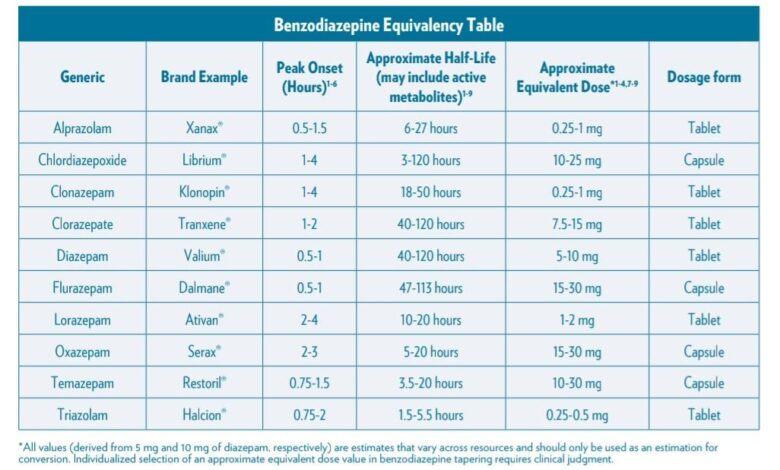Benzodiazepine Equivalency Table

Benzodiazepines are widely prescribed for a variety of conditions, particularly anxiety and insomnia. They are relatively safe and, with overdose, rarely result in death.
Benzodiazepines generally produce almost immediate effects, and thus may be prescribed for short-term, intermittent, “as-needed” use. Because many of the anxiety disorders wax and wane over time, patients with these disorders often prefer benzodiazepines because these agents can be taken intermittently, when patients feel the need to take them, and most patients can use benzodiazepines judiciously.
Benzodiazepines are also widely prescribed for other reasons, such as muscle spasticity, convulsive disorders, pre-surgical sedation, involuntary movement disorders, detoxification from alcohol and other substances, and anxiety associated with cardiovascular or gastrointestinal conditions.
Types of Benzodiazepines and how they work
Benzodiazepines differ in how quickly they start working, how long they continue to work, and for what they are most commonly prescribed.
• Diazepam (Valium) and clorazepate (Tranxene) have fast onsets of action and usually start working within 30 to 60 minutes.
• Oxazepam (Serax) has a slow onset, and lorazepam (Ativan), alprazolam (Xanax), and clonazepam (Klonopin) have intermediate onsets of action.
• Clorazepate (Tranxene), midazolam (Versed), and triazolam (Halcion) are short-acting agents with durations of action of 3 to 8 hours.
• Alprazolam (Xanax), lorazepam (Ativan), estazolam (Prosom), and temazepam (Restoril) are intermediate-acting agents with durations of action of 11 to 20 hours.
• Chlordiazepoxide (Librium), clonazepam (Klonopin), diazepam (Valium), flurazepam (Dalmane), and quazepam are long-acting agents with duration of action of 1 to 3 days.
Although most benzodiazepines are used interchangeably, some are most commonly used for certain conditions.
• Alprazolam (Xanax), chlordiazepoxide (Librium), chlorazepate (Tranxene), diazepam (Valium), lorazepam (Ativan), and midazolam are used for anxiety disorders.
• Clonazepam (Klonopin), clorazepate (Tranxene), lorazepam (Ativan), clobazam (Onfi), and diazepam (Valium) are used for seizure disorders.
• Estazolam (Prosom), flurazepam (Dalmane), quazepam (Doral), temazepam (Restoril), and triazolam (Halcion) are used for insomnia or trouble sleeping.
• Midazolam (Versed), lorazepam (Ativan), and diazepam (Valium) are used in anesthesia.
• Diazepam (Valium) also is used for muscle relaxation.
• Chlordiazepoxide (Librium) is used for alcohol withdrawal.
Benzodiazepine Equivalency
Evidence-based information on benzodiazepine equivalency is limited, and different sources may disagree; hence the use of dose ranges in this table. Even so, the data listed in this table are estimates, and their use requires clinical judgment.
Particularly when tapering a dose, a very gradual reduction with attention to patient response is required. This is particularly the case for patients who have been taking benzodiazepines for an extended period of time. When escalating a dose, it is preferable to err on the side of caution, to avoid overshooting and causing respiratory depression.
Benzodiazepine Equivalency Table
| Approximately Equivalent Oral Doses, mg | Time to Peak Level, hours | Half-life, hours | |
| Alprazolam (Xanax) | 0.5–1 | 1-2 | 12 |
| Bromazepam (Lexotan)* | 3–6 | 1-4 | 20 |
| Chlordiazepoxide (Librium) | 10–25 | 1-4 | 100 |
| Clonazepam (Klonopin) | 0.25–0.5 | 1-4 | 34 |
| Clorazepate (Tranxene) | 7.5–15 | 0.5-2 | 100 |
| Diazepam (Valium) | 5–10 | 1-2 | 100 |
| Flurazepam (Dalmane) | 15–30 | 0.5-1 | 100 |
| Lorazepam (Ativan) | 1–2 | 1-4 | 15 |
| Nitrazepam (Mogadon)* | 2.5–10 | 0.5-2 | 30 |
| Oxazepam (Serax) | 15–30 | 1-4 | 8 |
| Quazepam (Doral) | 10–20 | 1.5 | 25-41 |
| Temazepam (Restoril) | 10–20 | 2-3 | 11 |
| Triazolam (Halcion) | 0.25–0.5 | 1-2 | 2 |
| *Not available in the United States |
Download Benzodiazepine Equivalency Table Pdf





